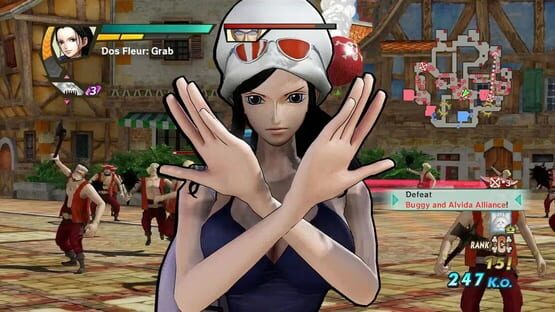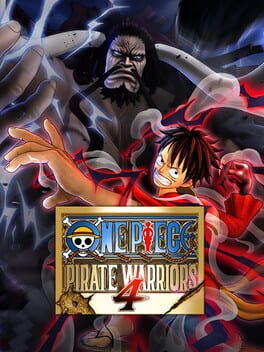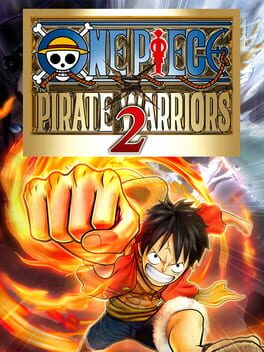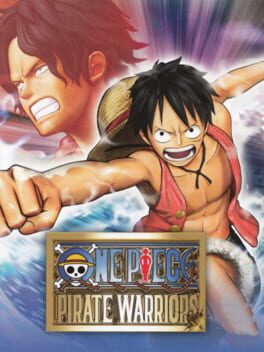

One Piece: Pirate Warriors 3
released on Mar 26, 2015
Enjoy the original story of ONE PIECE from Fuschia village, where everything has started, to the kingdom of Dressrosa, a mysterious island dominated by the evil Donquixote. Will your resolution be strong enough to defeat the most dangerous foes, including Doflamingo, Hordy. Jones, Ceasar. Clown and many more? Gather every member of the Straw Hat Crew, like in the original story, sail to the most emblematic places and enter the most epic battles: Marineford, Fish-Man Island, Punk Hazard and Dressrosa!
Also in series
Released on
Genres
Reviews View More
This is a game I’ve been looking at picking up for genuinely years. I watched an arc of One Piece in a movie night with some friends on Discord, and my close friend mentioned this game afterwards as a good way to get a good overview of One Piece (especially the pre-time skip stuff). Fast forward like 2+ years to only a couple weeks ago when I learned that this bad boy was not only on Vita and worked on the Vita TV but that it was also only 500 yen at Book Off, and I snapped it up as quick as I could x3. I played through both the adventure (story mode) and dream log (the challenge map mode, basically) modes all the way through and unlocked every character. I played the Japanese version of the game on real hardware (and I have no idea how long it took me, but it had to be at least 50 or so hours).
The story of Pirate Warriors 3 is basically just the story of the One Piece anime up through at least the start of the Dressrosa arc (which was airing when this came out in 2015 but wasn’t close to finishing, so this game just makes up an ending for it to cap off its story mode). While I’m not completely unfamiliar with One Piece, a lot of this game’s story was completely new to me, and for my money it does a pretty good job of translating the source material to Musou maps. It generally does this by turning one story arc into one map, but here and there you’ll get an arc spread over two maps, or some smaller unimportant (or difficult to Musou-ify) arcs just summed up in pre-mission briefings before actual levels. How well those are translated into Musou levels varies by arc, with some being still very effective despite how truncated they are here and others being so truncated that it’s honestly difficult to tell what’s going on or where certain emotional beats are supposed to come from. At the very least, I think they do a very admirable job of turning One Piece into a Musou game, and I by and large really enjoyed going through the narratives of each arc.
Being a Musou game, the overall gameplay is likely not difficult to guess for anyone familiar with the genre. You go around big maps killing hundreds or thousands of little unimportant generic soldiers as you complete objectives. These objectives often revolve around fighting other major characters, but they also include defending friendly hero units or capturing enemy capture zones. All that stuff is going to be extremely familiar to anyone who’s played a Musou game of basically any stripe since like 2004, and this game does it quite well. While there are a few pretty lackluster maps here and there (either for story or gameplay reasons), map design is generally quite strong and the 37 different characters feel very different and fun to play (albeit how balanced one will feel from another varies quite a bit).
What Pirate Warriors 3 does uniquely (or at least relatively so) among Musou games aren’t super extreme, but they do give the game a fun vibe apart from contemporary mid-2010’s Musou games like Dynasty Warriors Gundam, Dragon Quest Heroes, or Hyrule Warriors. Maps have extra semi-hidden objectives called Treasure Events that you can do for both extra story events and boons occurring for your side in the fight, and they add a fun flair to maps and a good encouragement to replay maps, even if they’re hardly a game defining addition. Another neat thing in maps is how you can link with an ally on the map and they’ll hop in to deliver an assist-like extra attack when you finish a combo (or you can summon them outright when you max out the gauge and do a super attack along with them). This is a tiny change, but it definitely changed how I played the game a fair bit compared to something like the Gundam Musou games. Being that you need to finish your combo to trigger their assist, it discourages just dodge-cancelling constantly mid-combo like the Gundam Musous’ combat systems do, and figuring out which kinds of assists work best with which player characters added a fun but not too complicated extra layer of depth to clearing out waves of enemies or taking on powerful enemy hero units.
The aspect of this game compared to other contemporary Musous that is most worth mentioning is how character leveling and advancement works. Where most other Musou games by this point had equippable weapons or armors you could find in stages or resources you could use to unlock further combo trees or move sets, Pirate Warriors’s bread and butter is in its character coins. Fighting as a character, fighting with a character as your assist, and outright defeating enemy hero units will earn you character coins of those characters. These can be used in between battles to upgrade your stats, and they’re a very meaningful aspect of upgrading power alongside simple leveling up (which can be done by just using a character or you can outright buy levels with in-game currency too). It’s a neat idea, and it certainly gives you a lot to grind for in certain cases, but it’s overall more of a hindrance than it is a help in my experience.
Especially in the story mode, it makes playing anyone but a few characters very prohibitively difficult unless you want to go back and grind for specific coins in past stages, as different characters require different (and sometimes far rarer) coins to upgrade their power levels. It made me stick to playing just a few characters a lot more than I would’ve liked, and it’s ultimately the game’s biggest weakness compared to its contemporaries. It’s not a huge weakness, as especially once you’re doing the challenge maps, you’ll likely have more than enough coins to mess around with a good few characters should you so choose to, but it definitely makes the story mode a bit more restricted than it already is in terms of who you can play around with and not expect to get the tar kicked out of you.
The presentation is really well done. There’s tons of music tracks from the show as well as original ones as well that make for fun, pumping fights during stages, and I found myself humming the main theme quite a lot in between sessions of playing. It’s just so catchy! X3. The graphics are also by and large very nicely done, and they do a really good job of translating Oda’s art style from 2D manga and anime into a 3D space. The animation and cutscene work is especially very done, recreating iconic scenes from the anime very well in climactic endings to fights, moving emotional scenes, and your more general special moves.
The one tiny critique I’d have for art design is that they’re clearly trying to have their cake and eat it too in regards to some characters’ pre-time skip character models. Some main characters like Luffy and Nami in particular look very noticeably unlike their more gaunt and less-built pre-time skip selves, and they’re clearly just their post-time skip models altered not nearly enough to have them fit in clothes they wore earlier in the show. It’s a very minor gripe, but it’s something even someone with only a passing knowledge of One Piece like me noticed, so I wouldn’t be surprised if a more dedicated fan noticed more weirdness here and there with other characters.
Performance-wise, this game is a real marvel to see run as well as it does on the PS Vita (or in my case, the PSTV). Enemy limits on screen are usually somewhere around 30 at a time, and I’d be interested to know if the PS3 version is able to up that at all, but generally speaking this game still looked great on my flat screen TV and I would’ve forgotten I was playing a Vita game if I didn’t have the little console sitting in front of me. There is some noticeable slowdown at some points when there’s a lot happening on screen, but it was never anything that really meaningfully affected gameplay for me. There are some other somewhat questionable design decisions in the controls like the lack of a lock-on button for fighting enemy hero units, but with just how fast some of them can teleport and whip around you, I can see why they didn’t end up including one.
Verdict: Highly Recommended. This is my new #3 favorite Musou of the modern ones I’ve played. It doesn’t quite have the polish of Hyrule Warriors (my #1), and it lacks the sheer amount of content that Dynasty Warriors Gundam Reborn does, but it still manages to be a really fun and colorful adaptation of what it’s bringing to the Musou formula. The quality of the included maps and characters carries strongly the lessons they’ve learned by their third time adapting One Piece, and it shows in just how fun it is. Where the Gundam Musou games helped make me a fan of Gundam, this Pirate Warriors game has helped me be a fan of One Piece, and if that isn’t high praise of how this adapts its license, then I don’t know what is~.
The story of Pirate Warriors 3 is basically just the story of the One Piece anime up through at least the start of the Dressrosa arc (which was airing when this came out in 2015 but wasn’t close to finishing, so this game just makes up an ending for it to cap off its story mode). While I’m not completely unfamiliar with One Piece, a lot of this game’s story was completely new to me, and for my money it does a pretty good job of translating the source material to Musou maps. It generally does this by turning one story arc into one map, but here and there you’ll get an arc spread over two maps, or some smaller unimportant (or difficult to Musou-ify) arcs just summed up in pre-mission briefings before actual levels. How well those are translated into Musou levels varies by arc, with some being still very effective despite how truncated they are here and others being so truncated that it’s honestly difficult to tell what’s going on or where certain emotional beats are supposed to come from. At the very least, I think they do a very admirable job of turning One Piece into a Musou game, and I by and large really enjoyed going through the narratives of each arc.
Being a Musou game, the overall gameplay is likely not difficult to guess for anyone familiar with the genre. You go around big maps killing hundreds or thousands of little unimportant generic soldiers as you complete objectives. These objectives often revolve around fighting other major characters, but they also include defending friendly hero units or capturing enemy capture zones. All that stuff is going to be extremely familiar to anyone who’s played a Musou game of basically any stripe since like 2004, and this game does it quite well. While there are a few pretty lackluster maps here and there (either for story or gameplay reasons), map design is generally quite strong and the 37 different characters feel very different and fun to play (albeit how balanced one will feel from another varies quite a bit).
What Pirate Warriors 3 does uniquely (or at least relatively so) among Musou games aren’t super extreme, but they do give the game a fun vibe apart from contemporary mid-2010’s Musou games like Dynasty Warriors Gundam, Dragon Quest Heroes, or Hyrule Warriors. Maps have extra semi-hidden objectives called Treasure Events that you can do for both extra story events and boons occurring for your side in the fight, and they add a fun flair to maps and a good encouragement to replay maps, even if they’re hardly a game defining addition. Another neat thing in maps is how you can link with an ally on the map and they’ll hop in to deliver an assist-like extra attack when you finish a combo (or you can summon them outright when you max out the gauge and do a super attack along with them). This is a tiny change, but it definitely changed how I played the game a fair bit compared to something like the Gundam Musou games. Being that you need to finish your combo to trigger their assist, it discourages just dodge-cancelling constantly mid-combo like the Gundam Musous’ combat systems do, and figuring out which kinds of assists work best with which player characters added a fun but not too complicated extra layer of depth to clearing out waves of enemies or taking on powerful enemy hero units.
The aspect of this game compared to other contemporary Musous that is most worth mentioning is how character leveling and advancement works. Where most other Musou games by this point had equippable weapons or armors you could find in stages or resources you could use to unlock further combo trees or move sets, Pirate Warriors’s bread and butter is in its character coins. Fighting as a character, fighting with a character as your assist, and outright defeating enemy hero units will earn you character coins of those characters. These can be used in between battles to upgrade your stats, and they’re a very meaningful aspect of upgrading power alongside simple leveling up (which can be done by just using a character or you can outright buy levels with in-game currency too). It’s a neat idea, and it certainly gives you a lot to grind for in certain cases, but it’s overall more of a hindrance than it is a help in my experience.
Especially in the story mode, it makes playing anyone but a few characters very prohibitively difficult unless you want to go back and grind for specific coins in past stages, as different characters require different (and sometimes far rarer) coins to upgrade their power levels. It made me stick to playing just a few characters a lot more than I would’ve liked, and it’s ultimately the game’s biggest weakness compared to its contemporaries. It’s not a huge weakness, as especially once you’re doing the challenge maps, you’ll likely have more than enough coins to mess around with a good few characters should you so choose to, but it definitely makes the story mode a bit more restricted than it already is in terms of who you can play around with and not expect to get the tar kicked out of you.
The presentation is really well done. There’s tons of music tracks from the show as well as original ones as well that make for fun, pumping fights during stages, and I found myself humming the main theme quite a lot in between sessions of playing. It’s just so catchy! X3. The graphics are also by and large very nicely done, and they do a really good job of translating Oda’s art style from 2D manga and anime into a 3D space. The animation and cutscene work is especially very done, recreating iconic scenes from the anime very well in climactic endings to fights, moving emotional scenes, and your more general special moves.
The one tiny critique I’d have for art design is that they’re clearly trying to have their cake and eat it too in regards to some characters’ pre-time skip character models. Some main characters like Luffy and Nami in particular look very noticeably unlike their more gaunt and less-built pre-time skip selves, and they’re clearly just their post-time skip models altered not nearly enough to have them fit in clothes they wore earlier in the show. It’s a very minor gripe, but it’s something even someone with only a passing knowledge of One Piece like me noticed, so I wouldn’t be surprised if a more dedicated fan noticed more weirdness here and there with other characters.
Performance-wise, this game is a real marvel to see run as well as it does on the PS Vita (or in my case, the PSTV). Enemy limits on screen are usually somewhere around 30 at a time, and I’d be interested to know if the PS3 version is able to up that at all, but generally speaking this game still looked great on my flat screen TV and I would’ve forgotten I was playing a Vita game if I didn’t have the little console sitting in front of me. There is some noticeable slowdown at some points when there’s a lot happening on screen, but it was never anything that really meaningfully affected gameplay for me. There are some other somewhat questionable design decisions in the controls like the lack of a lock-on button for fighting enemy hero units, but with just how fast some of them can teleport and whip around you, I can see why they didn’t end up including one.
Verdict: Highly Recommended. This is my new #3 favorite Musou of the modern ones I’ve played. It doesn’t quite have the polish of Hyrule Warriors (my #1), and it lacks the sheer amount of content that Dynasty Warriors Gundam Reborn does, but it still manages to be a really fun and colorful adaptation of what it’s bringing to the Musou formula. The quality of the included maps and characters carries strongly the lessons they’ve learned by their third time adapting One Piece, and it shows in just how fun it is. Where the Gundam Musou games helped make me a fan of Gundam, this Pirate Warriors game has helped me be a fan of One Piece, and if that isn’t high praise of how this adapts its license, then I don’t know what is~.



